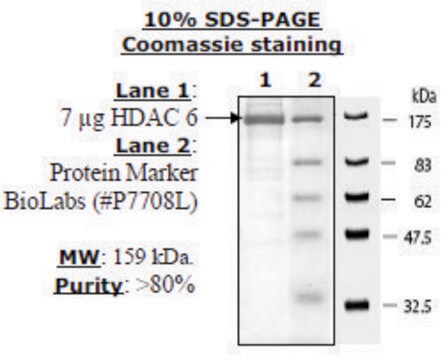CS1010
Histone Deacetylase Assay Kit, Fluorometric
sufficient for 100 assays (96 well plates)
Sinónimos:
HDAC Assay Kit
Iniciar sesiónpara Ver la Fijación de precios por contrato y de la organización
About This Item
Productos recomendados
uso
sufficient for 100 assays (96 well plates)
Nivel de calidad
Condiciones de envío
dry ice
temp. de almacenamiento
−20°C
Información sobre el gen
human ... HDAC1(3065)
Aplicación
The Histone Deacetylase Assay Kit provides a simple method for the detection of HDAC activity based on a two-step enzymatic reaction. The substrate for this enzymatic assay is a substituted peptide with an acetylated lysine residue and a bound fluorescent group. The first step of the reaction is deacetylation of the acetylated lysine side chain by the HDAC containing sample (HeLa cell extract, purified enzyme, etc.). The second step is the cleavage of the deacetylated substrate by the developer solution and the release of the free highly fluorescent group. The measured fluorescence is directly proportional to the deacetylation activity of the sample.
Acciones bioquímicas o fisiológicas
Histone deacetylases (HDACs) are enzymes that remove acetyl groups from histone proteins. HDACs are important regulators of gene expression and genome function. They are implicated in a number of human disease states, namely several cancers, neurological disorders, and aging. Therefore, HDAC are relevant key targets for therapeutic intervention. Moreover, histone deacetylase inhibitors have been shown to serve as anti-tumor agents.
Características y beneficios
The kit includes all the reagents required for the fast and easy measurement of HDAC activity in cell or nuclear extracts, or with purified enzyme preparations. In addition, the kit provides HeLa cell lysate as a source of HDAC activity for inhibitor screening or as a positive control, a HDAC inhibitor (Trichostatin A), and a standard to enable activity quantitation.
Nota de análisis
The Histone Deacetylase Assay Kit has been tested on HeLa, HEK 293T, NIH 3T3, and U 973 cell extracts.
Solo componentes del kit
Referencia del producto
Descripción
- Assay Buffer 20 mL
- Developer Solution 1.5 mL
- HDAC Inhibitor (Trichostatin A), 1 mM 50 μL
- HDAC Substrate, 20 mM 50 μL
- HeLa Cell Lysate 500 μL
- Standard (non-acetylated substrate), 4 mM 50 μL
Código de clase de almacenamiento
10 - Combustible liquids
Punto de inflamabilidad (°F)
188.6 °F - closed cup
Punto de inflamabilidad (°C)
87 °C - closed cup
Elija entre una de las versiones más recientes:
¿Ya tiene este producto?
Encuentre la documentación para los productos que ha comprado recientemente en la Biblioteca de documentos.
Los clientes también vieron
Bartosz Bieszczad et al.
Pharmaceuticals (Basel, Switzerland), 14(9) (2021-09-29)
Histone deacetylase (HDAC) inhibitors are a class of drugs used in the cancer treatment. Here, we developed a library of 19 analogues of Vorinostat, an HDAC inhibitor used in lymphomas treatment. In Vorinostat, we replaced the hydrophobic phenyl group with
Lin Du et al.
Journal of natural products, 77(7), 1753-1757 (2014-07-08)
The cyclic tetrapeptide 1-alaninechlamydocin was purified from a Great Lakes-derived fungal isolate identified as a Tolypocladium sp. Although the planar structure was previously described, a detailed analysis of its spectroscopic data and biological activity are reported here for the first
Jason D Plummer et al.
eLife, 10 (2021-03-31)
Methionine restriction (MR) dramatically extends the healthspan of several organisms. Methionine-restricted rodents have less age-related pathology and increased longevity as compared with controls, and recent studies suggest that humans might benefit similarly. Mechanistically, it is likely that the decreased IGF-1
Artículos
Epigenetic modifications are thought to occur through two key interconnected processes—DNA methylation and the covalent modification of histones.
Nuestro equipo de científicos tiene experiencia en todas las áreas de investigación: Ciencias de la vida, Ciencia de los materiales, Síntesis química, Cromatografía, Analítica y muchas otras.
Póngase en contacto con el Servicio técnico







